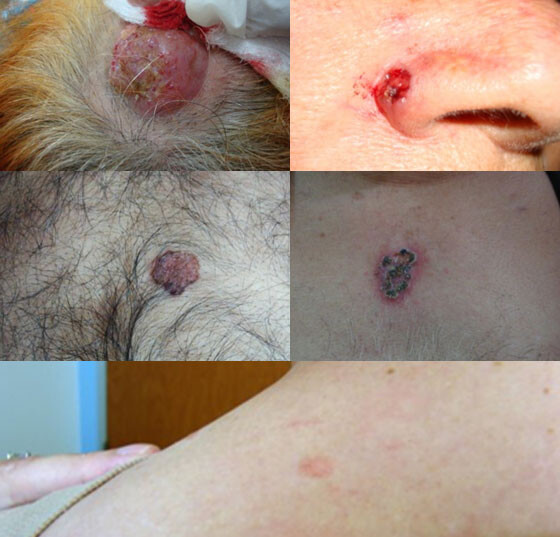Skin cancers are common in Australia and 2 out of 3 Australians will be diagnosed with a skin cancer by the age of 70. More than 2000 Australians die of skin cancers each year.
Non-melanoma skin cancers
Basal Cell Cancers
The commonest skin cancers are basal cell cancers followed by squamous cell cancers. BCCs make up 70% of all skin cancers. BCCs can develop in younger patients particularly in fair skinned individuals but is most common in people over the age of 40 years. BCCs usually develop on the head, neck and upper body. BCCs may appear as a pearly nodule, scaly area, dry area that is pale in colour or simply a sore that fails to heal. It may bleed or become ulcerated then heal and break down again.
Fortunately, most of these cancers can be cured by surgery if the cancer is detected early. In some cases radiotherapy is also required. In addition, there are non-surgical treatments which may be more appropriate in a select group of patients. This include various topical therapies as field treatments for superficial basal cell carcinomas. Some of these field treatments may require activation by a light source.
A small number of patients present with recurrent multiple and aggressive basal cell cancers. These patients are often co-managed with a medical oncologist. A selective systemic anti-neoplastic medication may be considered if the cancer has spread to surrounding areas (called locally advanced BCC) or spread to other parts of the body (called metastatic BCC), or if surgery or radiotherapy are not appropriate. This include situations where the surgery will lead to significant deformity or loss of an important organ such as the eye or ear or the cancer has returned after previous surgeries and further surgery is not likely to be successful. The medication works by controlling a key protein involved in aggressive BCCs. It may slow or stop the cancer cells from growing or may kill them. As a result, your skin cancer may shrink.

Squamous Cell Cancers
Squamous cell cancers accounts for about 30% of all skin cancers. They occur mainly in people over the age of 50 and usually appear on the skin most often exposed to the sun such as the head, neck, hands and forearms. Less often it can develop on the upper body or the legs.
SCCs may appear as thickened red, scaly spots which over a period of time bleed easily resembling a sore that will not heal. SCCs tend to grow rapidly over several months and can spread to other parts of the body. SCCs on the lips or ears have a high risk of spreading and should be seen by a dermatologist immediately.
Bowen’s disease
This is an early squamous cell cancer where the cancer cells are confined to the epidermis. It usually appears as red scaly spots. Bowen’s disease is often referred to a squamous cell carcinoma in-situ. A small percentage of about 5% can develop into invasive squamous cell cancer.
Moles and other benign lumps and bumps
The most commonest request is removal of a benign lump or bump such as a benign mole or cyst. They are removed under local anaesthetic in a minor operating room under sterile conditions. This procedure is not performed on the day of the consultation but are booked in after the initial consultation in order to give you the best cosmetic result.
